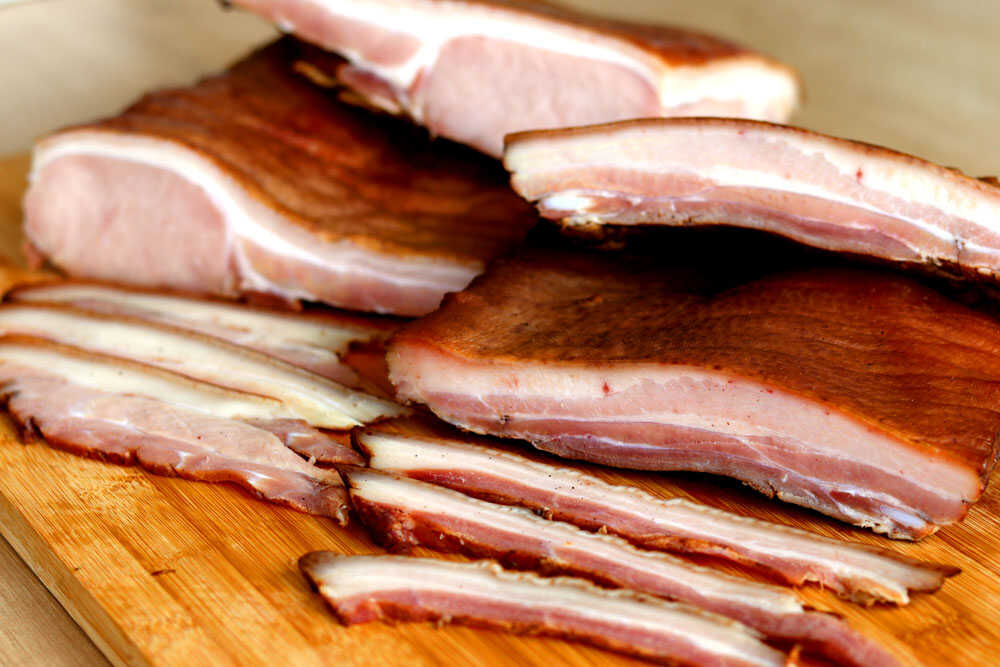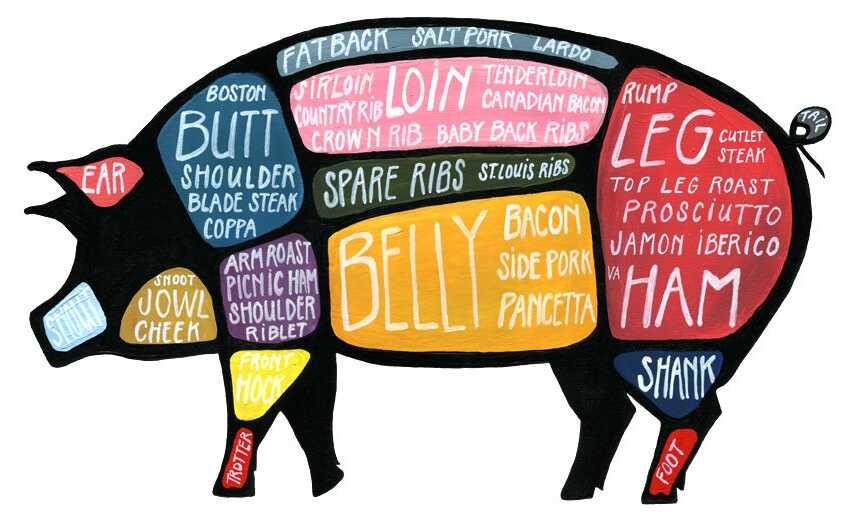
It is simple and rewarding to produce bacon by hand, it can be made both at home and in a professional kitchen or small refrigerator. The big advantage is the possibility of changing the seasonings, curing time, amount of salt and smoking or cooking. As bacon is an important ingredient in many dishes, changing its flavor can make a big difference in the final result of a preparation.
After initial curing, the bacon is hot smoked until it reaches an internal temperature of 65ºC, with direct smoke or immersed in liquid smoke before being finished in the oven or oven. It is possible to smoke on a barbecue, for that see this post about How to smoke on the barbecue? In this case, I made smoked bacon with direct smoke from burning wood, but there are two other recipes, one with artisan bacon without smoking, which anyone can make with minimal equipment and ingredients at their disposal, and another recipe with the artisanal bacon with liquid smoke, which also eliminates the need for a smoker. If you don't want or can't smoke, opt for one of these other recipes.
Bacon is the process and has no conditional relationship with the cut of meat, but the most common is to use pork belly. First you need to acquire a good piece of pork, which can be pork belly, which is basically a layer of skin, firm fat and little meat, coming from the lower middle part of the pig, close to the ribs of the animal's chest, in the image to the side is the part called belly. The thickness will vary greatly depending on the origin of the animal, pigs from large-scale productions tend to have a thin belly, with a thickness of 1.5 to 3 cm, while pigs from small productions, raised free range, can have a belly measuring 7cm in thickness. thickness.
After acquiring the belly, you can optionally remove part of the membranes from the upper part, opposite the skin. I recommend not removing the skin, as it serves as protection for the external layer of fat and can be easily removed after finishing, that is, when using the finished bacon.
Homemade smoked bacon ingredients
- 1kg of pork belly;
- 20g of salt;
- 20g of sugar;
- 3g of type 1 curing salt* (6.25% of nitrite and 93.75% of salt);
- 3g of erythorbate-based antioxidant**;
- 2g black pepper;
- 2g of allspice.
* type 1 curing salt It is a highly recommended preservative in smoked products, it prevents botulism, which comes from bacterial contamination that produces a very dangerous toxin in anaerobic environments, such as smokers.
** erythorbate antioxidant it works together with the curing salt, enhancing its effect, fixing the reddish color of the meat and preventing rancidity.
Preparation of artisanal smoked bacon
Clean the belly, mix all the ingredients and rub well on both sides of the meat, until it is evenly distributed.
Place the seasoned piece in a plastic bag or container with a lid and leave it in the refrigerator for 3 to 7 days, depending on the thickness of the belly. During this time, the cure will have time to act completely and the seasoning will be well distributed. I rolled the piece and placed it in a tightly closed plastic bag. I consider it the easiest way to proceed, making it easier to turn the meat and taking up less space in the fridge.
During the process, some liquid may come out of the meat. Turn the piece daily so that the ingredients are evenly distributed.
At the end of this step, remove the meat from the bag/pot, discard the liquid, rinse quickly and dry. Hang or place on a rack in the smoker and begin the bacon smoking process.
Keep the smoker at a temperature close to 90ºC for 2 hours or until the inside of the bacon reaches a temperature of 65ºC. The smoke flow can vary depending on the desired smoking intensity. It is possible to smoke on a barbecue, for that see this post about How to smoke on the barbecue?











Hello everyone. I made this recipe, purchasing the products from the store. It was simply perfect. The products arrived on time, and I live in Acre. If you can make it, I recommend it! Excellent! Congratulations.
I made smoked bacon on a barbecue, the flavor was good but the skin was super hard, why is that?
Goodnight. What model would this smoker be?
fenix product smoker
If you get too little smoke, what should you do?
You can smoke for longer, with a reduced smoke flow, that is, with more concentrated smoke.
Congratulations on the content, very didactic and well presented. I'm going to buy the smoker, I think it's excellent!
But I have two layman's questions: (1) Could we remove the curing salt from the recipe, not use it; and (2) could we use rosemary oil in place of the antioxidant?
Hi André, curing salt helps protect, especially against botulism, but it is only mandatory for those who sell bacon, for personal consumption it is optional. Regarding the antioxidant, yes, rosemary extract, in oil or powder, is an excellent antioxidant.
I really like the recipes on the site and congratulations in advance for sharing the information. I've always made pastrami and beef bacon based on the recipes here.
I would like to know if you have tried making “beef bacon” (in quotation marks because many people do not accept that bacon comes from any animal other than pigs).
I'm an Adventist, and I'm always testing new recipes that don't contain pork.
Thank you in advance for your willingness to share your knowledge and learnings with everyone.
Hi Cleber. Thanks! I'm happy to know that you have used our content for your productions. Bacon is the process so it can be made with any meat, but there really is this tradition with pork and many people don't accept other meats, but this rule is more cultural. I've never made it with beef, I'll research it and test it.
Thank you very much, Eduardo! And I believe many will be interested.
Today I started curing another piece (I'm doing it with sirloin, but I almost always do it with beef brisket). And I've been making it in the oven with liquid smoke, according to the penultimate bacon recipe you posted.
Thank you very much again for the content provided, and I really hope you post some beef bacon.
Hug.